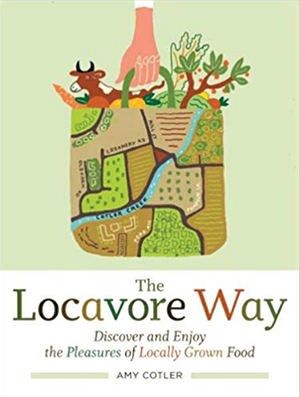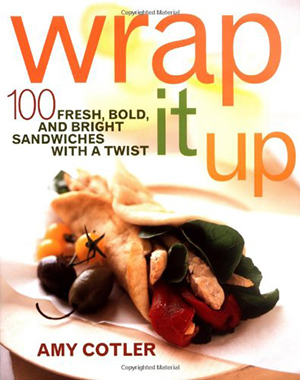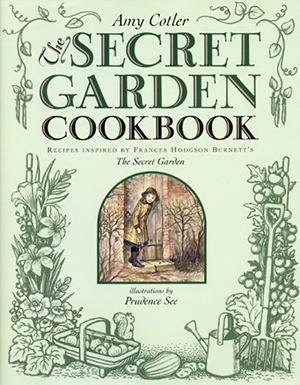
It’s impossible to ignore Hoi An’s appeal. Small bridges run across Thu Bon River, which meanders through town, bordered by semi-distressed, romantic French colonial buildings. The town’s signature lanterns twinkle at night. And during the day, it’s a snap to bike or walk, as many of the streets are closed off to cars. Good eats abound and the beach is within easy reach. We planned to stay three days and jubilated for twelve.
In some ways Hoi An reminds me of San Miguel de Allende, Mexico, where we now live. Both towns are ancient World Heritage Sites that capture the ups and downs of that designation: well-preserved and irresistible beauty paired with lots of tourists, shops and a self-consciousness about that beauty. Yet, peering across the river in the early morning, I felt that travelers’ thrill — transported back in time to something “other.”

Walking and biking through neighborhoods to get around, we passed kids playing with dogs, kumquat trees heavy with fruit, and always the same tiny old woman who nodded hello. Fifteen minutes to town, fifteen to the beach. Hoi An revitalized us after 3-1/2 months on the road in (links) New York City, London, Bangkok, traveling up through Northern Thailand, to Laos and Hanoi. It helped that we stayed in a fabulous, but reasonably priced, guesthouse just a few minutes out of town.

Tailors Galore
Hoi An is known for its look, good eats and tailors. The streets are lined with 600+ tailor shops where you can step in one day and out the next with clothes made to order. Pick a fabric, a pattern, bring your old clothes to have them copied. Even for a gal like me, who at times wished I were assigned a uniform at birth, it was a blast.
These people, and the Vietnamese in general, keep reminding me of my relatives — warm, but pushy, loud, money conscious and quick to emote the full range of human feelings. Here, they’re in the rags business, as my relatives were too, starting out in Lower East Side pushcarts, moving up to clothing stores over many years in the Big Apple.
One day I forgot my purse in a tailor’s shop, so went back to pick it up. When I stepped in to ask, almost in unison, the sales women said AA-MY!, High for A, followed by a dropped low note for Y — the exact tone my Great Aunts would have used to kindly chastise my poor habits.

A Food Town
If you want to really experience a town, forage the food markets early. So, on my first morning I biked into town, joining an Australian chef I’d met on the road. We hit the riverside market at 7 am, when no tourists were in sight.
Along the river, I immediately spotted a woman sitting on a tiny stool, ladling up warm black bean pudding with coconut from a giant pot, a smashing breakfast. (Get there early, as she runs out.)

Walking a tad further, we took a severe left, away from the endless variety of gorgeous fish for sale along the river. We sat at low stools at a long table, where a woman ladled up a vegetarian soup with fresh pumpkin and tofu. A cheesy condiment that may be fermented bean curd held a sourness that mingled perfectly with our herbaceous soup. These mini-feasts, served by women tending a tidy stand or squatting roadside by pot or skillet, were some of my most memorable delights in Asia.

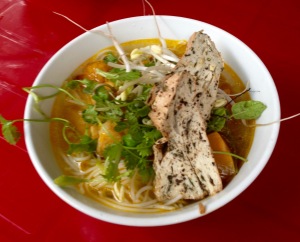
There’s also a long covered market with rows of vendors selling everything imaginable. But the vendors were so assertive, and it was so mobbed that I had to pull my poor husband aside and walk him to a calmer place. I don’t mind crowds, but he does, and traveling well as a couple is an act of compromise. Still, I managed to grab a bowl of Cau Lau and take it outside.

One morning, wandering alone, I noticed another vendor serving up warm bean curd custard topped with gingery palm syrup. Immediately, two 20-something women sat next to me on a few curbside steps. When asked, I told them I was an American. Excited, they wanted to practice their English, as is so often the case.“We love Americans, “they told me.
“Why? After the war?….” I asked.
“Because they’re so friendly,” one replied grinning, before calling out for the pudding cold, with ice, which she rapidly stirred, breaking up the curds.
It’s hard to have a bad meal in Hoi An if you avoid the usual tourist restaurants in old town that sell too many east-west meals. Stick with the market and solid recommendations. And the food was much easier to navigate than in Hanoi.
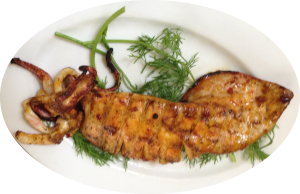

One afternoon, we found our way down an alley where we sat on sidewalk chairs at a long table alongside other hungry patrons of Bale Well, where they’ve been serving the same dish for 23 years. The proud owner, Mai, showed how to roll her rich and wonderful combo of skewered grilled pork, spring rolls, lightly pickled vegetable salad with fresh lettuce and fresh herbs into a rice paper, with or without the Vietnamese turmeric colored-pancake (Bánh xè), before dipping it dark soya-based sauce. This memorable meal could stop a truck!

Later we went to the upscale, but not fancy, Ms Vy’s Morning Glory Restaurant, as well as Vy’s Market, two of her four businesses in town. The Market is specifically geared for foreigners to navigate into Vietnamese food. It’s a series of stalls, each featuring a different aspect of the cuisine, from workers’, wok or fried food, to my favorite — the “weird and wonderful” category with unctuous brains, multi-textured duck and jellyfish salad. Choices of everything, most of it more conventional, including the elegant Banana Blossom or the Shrimp and Pomelo Salad, are easy to find on her pictorial IPad menus. Upstairs, there’s a school where I took her “advanced” class, a snap to handle for any home cook. The simple local clams in lemon grass broth were orgasmic.

One evening I was “home” with a cold feeling sorry for myself because, poor me, I couldn’t consume another Vietnamese meal. Tommy appeared, bearing Bahn Mi, still warm, on crisp baguettes, layered with meats, vegetables and several sauces, who knows what. Rich and pickled flavors, paired with a touch of hot and sweet, transcended my fever, reinforcing my affection for my sweet hub. We went back three times and discovered Anthony Bourdain loved it too.

After glorious meals in town, with its bridges lined with lanterns, bustling with night shoppers, we were happy to return to our Vietnamese neighborhood, complete with complimentary bikes, breakfast and morning roosters. The bike shed at our hotel looked out on the organic farm next door, emerald green, with a small cooking school and restaurant inside. We ate lunch there, looking out of the neat rows of greens, while nibbling “Three Friends”, a bundle of marinated pork and sweet river shrimp, tied with spring onion (and mint) and garnished with a tiny flower. (Pop the whole thing into your mouth.)
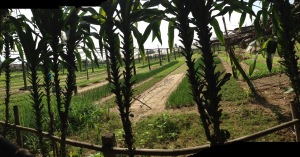

One rainy night, we ducked into a huge restaurant set for a banquet, but empty. We ordered the signature dish, chicken, from a warm waitress who sat at the table with us. Soon we heard cackling; the chicken was being killed for us. The waitress took my hand, inviting me to join her in the tiny kitchen, which was simply a grill with our bird , split and cooking. The chicken was tough, so we brought it back to Hoa, our guesthouse host, who’d said she liked the restaurant. But it was a Buddhist holiday, so she couldn’t eat it, as meat is forbidden. All food experiences aren’t tasty. But they’re experiences nevertheless.

Beach
We regularly biked past a rice field out of town to the Cau Dai beach. Often we heard tourists complaining about the aggressive parking attendants. But Tom earned regular hugs and laughs from an elderly woman after gaining her respect by haggling the price. The long beach had intense waves and an undertow, but we relished it anyway, sitting under shady palapas, eating good enough sandwiches and drinking mango shakes. Sweet.

Slow Travel
Our 12 fabulous days in Hoi An didn’t start well. We were driven from the Da Nang airport in dreary weather past China beach, a long strip of white sand that served as an “RNR” spot for US soldiers during the war.
The sky was darkening as we arrived at our guesthouse, which was slightly out of town. Driving past a ramshackle shed next to a smoking makeshift fire, I could feel Tommy tense beside me. The neighborhood was litter-scattered where sidewalks should be, low lying metal roofs revealing nothing. No one around.
The sun lifted in the morning, filling our spotless and spacious room with its grand en suite bathroom. And after a few days we began to notice neatly swept concrete yards in front of homes, some quite ornate, pets sleeping out front. Kids appeared in the afternoon, playing ball in the street, practicing their “hello,” as we passed each day. And we started to peel the layers of the onion that goes with slow travel, seeing beyond the odd façade a foreigner can’t place when they first arrive.

There’s a simple pattern that evolved on our journeys, perhaps common to all travelers. First you get your bearings, instinctively trying to relate an unfamiliar place to something you know. What here reminds you of a neighborhood back home? In London, my unaccustomed eye tried to compare the city’s look to the older part of Manhattan, at the tip of the island, where the buildings are kind of, well…. old Brit. In the outskirts of Hoi An, I looked for the small towns in Laos where I’d just been, but didn’t quite see them.
But soon your eye adjusts and you don’t have to compare. You look at what’s there. Then you begin to recognize faces, or at least to recognize their warmth. In Hoi An, we began to smile at our neighbors as we passed each other on the short cut Tommy discovered into town. That tiny old woman in a conical hat who nodded hello as we walked past the kumquat trees next door to our guesthouse.
All our neighbors are becoming increasingly friendly. One asked Tommy, ”Do you live here?”
Another, “Where’s your hat?,” when Tom forgot it one day.
Soon we were slipping off our shoes before entering that guesthouse, relieved to be home, chatting in half sentences to the owner, Hoa, about our day and hers. There was comfort in both the commonality and differences in our days — ours exploring alleyways, hers tending to her business. One night, it dipped down to 75 degrees. We joked with her about wearing a goose down jacket, showing her how high the snow sat above our picnic table back home. Another, we gathered in the foyer while it was pouring outside. Hoa touched the flat of her hand to a spot on the reception desk, two feet off the floor, where the rain rose last year. Her small daughter watched TV, dancing in sync with the kids on screen, while her older brother stood behind us, jealous of the attention we gave her.

The longer we travel, the fewer sights we see. No doubt, I’ve seen places that will never leave me. Angkor Wat. Ephesus. But what I remember most is often lacking in world-class wonder. Those evenings in Hoi An. The elderly parking attendant and her hugs. A Turkish resort on the Aegean Sea, where my young daughter drew the chef’s portrait in exchange for two juice boxes. Clusters of children squatting over fires, cooking their meals in a rural school in Northern Laos, in the shadow of a bomb-torn mountain. A sloshing fish tank balanced on the back of a motorcycle in Kampot, Cambodia as we drove into town.
Traveler’s Tips
Where we stayed (and would gladly stay again)
- Village Moon Homestay is run by two lovely cousins, Vy and Hoa, who call themselves sisters. Only 5 rooms, with outdoor areas. Fabulous and very reasonable, with breakfast included. Right between town and the beach. One of our favorite spots in Asia/
Some good eats
- White Rose for Dumplings: 533 Hai Ba Trung
- Banh Mi Phung, for crusty Bahn Mi sandwiches, 2B Pan Chau Trinh
- Bale Well: 45/51 Tran Hung Dao Street, in an alleyway between Trần Hưng Đạo and Phan Châu Trinh.
- Miss Vy’s many restaurants. We ate at the Morning Glory and Vy’s Market, where there are also cooking classes.
To do
- Old Town itself is the main the attraction in Hoi An. ( We paid to enter on our first visit, then didn’t) Other things to do and see.
- Japanese Covered Bridge’s Pagoda, constructed in the 1600’s
- We loved what we bought at Blue, and the price was right, although some of the clothes wore better than others. I suggest you look for recommendations on-line though, as businesses change, and apparently there are some scams.
- My Son (as in caption)

One morning, Tom and I took a crowded and rushed, but cheap, tour to another World Heritage Site, the ruins of My Son, which were 70% destroyed by US bombs in 1969. In relentless sun, we walked around mythic, but quite rubbly temples with greens trying to engulf, which sat beside bomb craters filled with rain. Later that day, we were asked whether we wanted a tour of the infamous My Lai nearby, the site of the history American slaughter of Vietnamese civilians. We politely declined.



